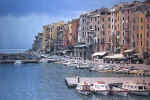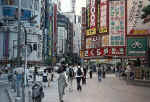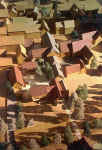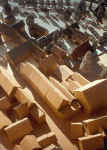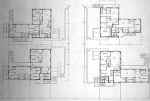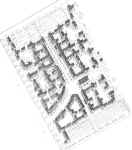 |
|||
 |
|||
|
Vol. 6, No. 2 (January
2002)
|
|||
| Ordinary Form Language: Projects in Breuberg, Germany, and Eugene, Oregon, USA |
|||
|
__Susan
Ingham Eugene, Oregon |
|||
Introduction
In the description for the Form Languages in
Architecture Symposium (Dresden, Germany, June 22-23, 2001), the term “form
language” is defined as “the elements, characteristics and principles of
architecture which repeatedly appear in the forms of buildings, the designs of
individual architects, the forms of a particular building culture, and more
recently, the forms of particular global schools of design architecture.”
This definition implies that form languages exist in multiple
manifestations, and at all levels of scale. In its most general definition, a
form language can be understood as a combinatory system, made up of common
identifiable physical elements in a built environment. Examples of easily
identifiable form languages include the elements that make up such traditional
environments as walled medieval towns, or the medina in an Islamic city, or
various historical styles, such as the International Style, with its emphasis
on minimalism and steel and glass construction, or the work of a single
architect, such as Frank Gehry with his use of swooping curves, and
juxtaposing forms.
It should be noted that a form language is quite distinct from a pattern
language. Patterns, as defined by Christopher Alexander and his colleagues in
the book A Pattern Language, are
solutions to functional or social problems in the environment: “The elements
of this language are entities called patterns. Each pattern describes a
problem which occurs over and over again in our environment, and then
describes the core of the solution to that problem, in such a way that you can
use this solution a million times over, without ever doing it the same way
twice.” (Alexander, et al., A
Pattern Language, Oxford University Press, 1977.) Thus, pattern languages,
unlike form languages, do not address the particular form or physical
appearance of a building or a place, but rather address the underlying
functional or social problem. In contrast, form languages are made up of forms
– physical parts and entities that when combined together create a building
or place with a distinct form and structure.
This paper explores one type of form language, one which can be termed “ordinary
form language”, and may be defined as the form language of ordinary
buildings that when taken together help to define the unique character of a
particular place. This ordinary form language is comprised of the physical
characteristics of fabric or ground buildings rather than object or figure
buildings. There is much emphasis today on object or figure buildings (extra-ordinary
buildings), and their requisite superstar architects. Many cities in the world
aspire to attract a superstar architect to design a signature building in
their city in order to gain international recognition (Frank Gehry’s
Guggenheim museum is a well-known example of this, as the city of Bilbao,
Spain, is now internationally known as a result of the existence of a single
building). Ordinary form language does not include these special object
buildings; rather it is about buildings that make up the fabric of a city or
town and give a place its particular character and identity. The term “ordinary”
also can be understood as a form of resistance against the current trend
towards the object or signature buildings previously mentioned. The
designation “ordinary form language” imparts importance and legitimacy to
those buildings and structures that form the fabric of a place and are
essential in defining the character or essence of a city block, a neighborhood,
a town, a city, or a region.
Ordinary Form Language
We all know examples of ordinary form languages from our own experiences. The following images illustrate ordinary form languages as they exist at different scales and in different cultural contexts.
Given these challenges, how then is it possible to successfully work within
the context of an ordinary form language?
How can architects try and create buildings and places which intensify
the existing form language and not just imitate it?
Are there some processes and techniques that can be learned and applied?
There are a few well-known architects who have worked or are currently
working mainly with ordinary form languages: Hassan Fathy’s work in Egypt,
Andres Duany and Elizabeth Plater-Zyberk’s work in the US, and Christopher
Alexander and his colleagues’ work at the Center for Environmental Structure,
based in the US, are a few of the best known. Many other less well-known
architects are beginning to address some of these challenges as well,
contributing to the work of these predecessors, and resisting the current
zeitgeist of the glorified superstar architect hired to design his or her
signature building. The following projects are two attempts to design and
build structures that work with an ordinary form language. Each project
addresses some of these issues, and certain common principles and processes
were used in the projects’ design and creation.
Wertheimer Tor Mixed-Use Housing Project
Breuberg, Germany
Architect: Hajo Neis &
Associates

|
Figure 3: The town of Breuberg, Germany, showing the main street, the two market squares, the castle, the river, the Ochsen and the project site (dashed lines). |
Located in the old castle town of Breuberg (Hessen), Germany, the Wertheimer
Tor Mixed-Use Housing Project is a phased project that includes the renovation
of an old inn building (the Ochsen), a cafe and a new square along the main
street, the addition of new housing units (including facilities for a small
co-housing community), and a new pedestrian bridge over a river. Breuberg is a
very traditional town; it is structured along a main street, and bounded by a
castle on a hill on one side and a small river on the other. There are two
existing market squares along the length of the main street, with a church
located in the larger of the two squares. Most of the buildings in the town
are at least 100 years old, and are concentrated along the length of the main
street. The forms of the buildings are basic rectangular blocks, one or two
stories high, with additional stories within the steep roof structure. The
construction system most commonly used in Breuberg is traditional heavy timber
post and beam, with thick plaster walls and half-timbering, steeply pitched
roofs, and small dormer windows. The buildings are typically sited with their
gable ends facing the street. In the 1960s during an urban renewal period,
several of the buildings along the main street were torn down, creating a
wound in the town fabric. The Wertheimer Tor project is an attempt to heal
this wound, first by renovating the old inn building, and then constructing
new buildings that would then knit the town fabric back together again.
Given the traditional environment of the Wertheimer Tor project and the
existing strong ordinary form language, we as architects were faced with the
challenge of how to design and build modern structures within this very
particular ordinary form language and traditional context. We used three
principles and processes that were particularly helpful for us at various
stages of the project: creating a Project Language with users and townspeople,
performing full-scale stake-outs directly on the site, and implementing a new
construction system. Each of these principles and processes will be discussed,
particularly as they relate to enhancing the existing ordinary form language
of the town.
1. Creating a Project Language
A Project Language distills and describes the essence
and character that a specific building project will have, and defines its
connection to the town as a whole. The particular character of the project is
presented in a carefully structured sequence of statements and sketches
compiled from observations and interviews with users, town residents, and
other interested parties. The key aspect of a Project Language is that it
describes the exact nature, essential components, and relationships a project
and all of its elements will have, yet at the same time it also maintains an
ambiguity as to the specific form of the project.
In the case of the Wertheimer Tor, we developed a
Project Language for three primary reasons: 1. to better understand the
importance of the site and the wound in the town fabric, 2. to define and
illustrate the qualitative aspects of the project, and 3. to document the
visions that the townspeople and users had for this special place. The Project
Language became a written document that described the qualities and visions
that were hoped for for this area. One vision that became very clear was the
desire to create a third square for the town, strengthening the main street:
“The old buildings of the town spring from and shape
a single beautiful main street running along the base of the castle mountain.
Two ‘jewels’, the old market at one end and the new market roughly in the
middle, widen the street and form two essential nuclei of the town. At the
other end of the main street of the town, in the area of the Wertheimer Tor,
is an open wound in the fabric of the street and the life of the town. In this
area the project creates and helps to recreate the third jewel and third
essential nucleus of the town and forms a new square along the street as the
center of this nucleus.”
The following are two more excerpts from the completed Project Language, based
on the thoughts and visions of the people of the town:
“A fountain on the new square – somewhere on the new square there is a
fountain, from which one can look through an open gateway to the inner
precinct of housing and the realm of the meadows and river beyond.”
“A wooden bridge over the river – the bridge is a beautiful covered heavy
timber structure. It marks the southern point of entry into the project and
the path to the square and the main street.”
While the Project Language does not address the exact forms or placement of
the new structures, it does provide a qualitative framework to support the
evolution of the project’s design. This relationship is similar to that of
Breuberg’s existing ordinary form language, and Breuberg’s history of
builders. The ordinary form language that was created and developed by
centuries of builders, also provided the qualitative framework to continue the
growth of the town. As a result, every building in Breuberg is unique, yet
they all have a particular family resemblance to one another that helps to
create Breuberg’s particular character and identity.
2. Performing Full-Scale Stake-Outs
After completing the Project Language, we began to
study the site itself; visualizing where the new buildings should be placed in
order to try and knit the town back together. We did this by conducting
full-scale stake-outs at the site, using poles and string, to get a more real
sense of the actual size and impact of the new structures. We started to get a
sense of where the new square along the main street would be located, and the
new buildings that would help to define it, and we also determined that a new
building could be connected to the Ochsen building and form a kind of gate
that would then lead into the courtyard of the small co-housing community and
continue through the rest of the project to the pedestrian bridge. The
co-housing component of the project, coupled with the rehabilitation and
renovation of the Ochsen building, would comprise the first building phase, so
we developed this area first, including the pedestrian bridge.
While doing the stake-outs, it immediately became clear what kinds of shapes,
volumes, and positions are best for the new buildings, especially given the
close proximity of the existing historical context. Small changes in size,
shape, or position often had a large effect on the feeling and character of
the emerging spaces. It was also during this process that we began to start
working directly with the idea of continuing the ordinary form language of the
town, particularly in terms of massing and volumetric shape. Thus, in taking
our cues from the existing context, we continued the existing form language of
long rectangular shaped buildings, two or three stories in height, with
steeply pitched roofs. Once the stake-out was completed, we recorded the
results, first in drawing form and then as a model. This then became the
larger structure, or framework, from which the actual lay-out of the
particular spaces and apartments would spring. One of the most satisfying
aspects of this process is the feeling of confidence that we as designers felt
as we proceeded with the details of lay-out and program requirements. In
performing the stake-outs, we knew with a great deal of certainty the exact
location and massing of the various building volumes; this knowledge was very
important to keep in mind as the demands of program became increasingly
important. Our building priorities and limitations were set as part of a
larger structure, within which the various program requirements would then be
incorporated. Through this process, we were able to incorporate the program
into the larger structure of the site, rather than have the program dictate
the overall structure of the project. This emphasis on first defining the
larger structure of a site based on form and mass rather than on program
requirements, is an unusual process, but it is one that has been valuable to
us in connecting a building to its site and its context, and thus
strengthening the ordinary form language of the particular environment.
3. Implementing a New Construction System
While it was fairly easy to work within the existing
form language in terms of the size, shape, and placement of the buildings,
working with the traditional heavy timber and thick plaster construction
system was not possible or desirable. Our challenge was to select a
construction system that would work within the existing form language of thick
walls, while at the same time utilizing modern technology. We chose an
integrated concrete tile and wood system that the principal of the firm, Hajo
Neis, helped to develop in Japan. The concrete tiles form the exterior of the
building, and are tied into place with a 2x6 wood frame. A couple of inches of
concrete are poured into a cavity which then locks the system together. The
advantages of this system are that it forms an integrated structural system as
a thick solid wall, and it allows for unique tile patterns to develop as part
of the exterior surface. For the Wertheimer Tor project, we plan to use
different patterns of tiles for different buildings and different parts of the
project.
One noteworthy aspect of this construction system is that it works within the
existing ordinary form language of the particular place, yet at the same time
uses modern technology to create something new. Often in traditional contexts,
an architect’s response is to design something very light and very different
in style and form to the traditional structure, so that one is acutely aware
of what is old and what is new. In this case, it is clear that these buildings
are new, but they still attempt to work within the context of a traditional
form language. The physical result is more of an effect of integration rather
than separation, continuing the structure of the existing form language,
rather than reacting against it.
Agate Street Student Housing and Amazon Student
Housing Village, University of Oregon
Eugene, Oregon, USA
Architect: Christopher Alexander
and the Center for Environmental Structure, and Thallon & Edrington
Architects
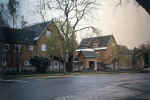
|
Figure 6: Agate Street Student Housing, Eugene,
Oregon |
The second project that I will discuss is comprised of two parts, one built
and the other unbuilt. Both projects are student housing projects at the
University of Oregon in Eugene, and both were designed as a joint venture with
Christopher Alexander’s Center for Environmental Structure and Thallon &
Edrington Architects. The first part, the Agate Street Housing project,
consists of twenty student apartments, and served as a prototype for the
second part, the 300 unit Amazon Student Housing Village. The existing
conditions around both sites were quite diverse, with no consistent or strong
form language present, so the challenge for both of these projects was to try
and create an ordinary form language within the projects themselves. Future
building projects could then continue this form language, in order to help
strengthen the larger identity of place in these areas as well as in the city
of Eugene as a whole.
Trying to create our own form language within both of these projects was quite
difficult. Most environments that have strong form languages have been created
over centuries of building, with many different architects and builders taking
part. How is it possible for one group of architects over a short period of
time to try and make a collection of buildings that attempts to have some of
the rich characteristics of these kinds of environments?
Again, we looked to certain principles and processes that could help us
as we tried to create a strong form language for these projects. These
principles and processes are: the creation and use of a Pattern Language that
could be applied to both sites, the use of a prototype building and the
process of variation, the creation of positive space, and the construction of
mock-ups to test particular spaces and materials. Again, I will discuss each
of these principles and processes, particularly as they relate to enhancing
the existing ordinary form language:
1. Creating a Pattern Language
As in the Wertheimer Tor project, we started work by
creating a pattern language for both the Agate and Amazon projects, using
students and university representatives as our user group. Because the
language would be used for two different sites, the more general form of
language “pattern language” was created rather than the more specific “project
language” used for the Wertheimer Tor. However, the purpose and use of the
language is similar: to create a document that specifically describes the
qualitative aspects of the project, the hopes and dreams of the user group, so
that everyone can understand it as a clear vision. Examples from the Agate/Amazon
pattern language include:
“New student housing should be seen as an opportunity
to strengthen the identity and character of the existing neighborhood”
This pattern is directly related to the creation of a
form language for the two particular sites.
“Clustered Buildings, Common Greens and Outdoor
Spaces”
Buildings provide some shape to the outdoor space that
surrounds them. These spaces need to acknowledge the need for a hierarchy of
open spaces that range from those intended to benefit one or at most two units
to those which serve the whole village.
“Parking at least 200’ from the Average Apartment”
Although people often want to be near their own car,
when asked how far they want to be from a parking lot, the distance gets much
bigger. The users see a parking lot close to their home as being unpleasant,
potentially dangerous for children, and detrimental to a peaceful life.
“Warm, Solid, Low-Maintenance, Safe Materials”
“Pedestrian Spine with Quiet and Graceful Character, Where All Pedestrians
Meet”
“Inhabitants Feeling of Being a Person, not a Soldier in a Barracks”
“A Tiny Forest”
From this written document, the beginnings of a form language start to appear,
within the framework of this larger vision.
2. Developing a Prototype Building that Allows
for Variation to be Generated
Since the budget for these projects was extremely small
(about $65 per square foot), it was necessary to think about Agate and Amazon
as incorporating very simple and uniform building shapes, with standardized
details. Yet it was also crucial to allow for some variation so that the
projects would not feel too stamped out, or too much like mass housing or
barracks. The challenge for us was to create a simple prototype building form
that when clustered together could allow for some variation in the emergence
of a coherent whole. After much experimentation, an L-shaped building evolved,
with a thinner one and a half story volume attached to a larger two and a half
story structure. This L-shaped form became the basic unit, but would have the
flexibility to change as required by the site or placement of the buildings
and secondary elements.
In the case of the Agate Street project, four of these buildings were needed,
each consisting of five separate apartments. The basic lay-out for the
buildings was at first quite symmetrical around a central courtyard; subtle
variation was then allowed to occur based on site conditions, the pattern of
stairs and entrances to each unit, and the lay-out of the apartments
themselves. The result of this is that each unit is different from the others
as it responds to these particular conditions. In the plan below (Figure 7),
we can see some of the variation that has occurred. While at first the
buildings seem the same, in reality they are not. For example, the wing of one
of the buildings is offset in order to keep an existing tree on the site.
Other variations include the position of stairs and entrances to each
apartment. One pattern that evolved in the project was that each living room
must face south. In order to achieve this, variation had to occur with the
placement of the stairs and entrances. This resulted in the lay-out of each
apartment becoming slightly different, which then affected the window and door
patterns for the exterior. These internal and external building variations
also influenced the shapes of the more minor exterior spaces and pathways.
When combined with the existing trees, these minor exterior spaces became
quite differentiated, strengthening the existing form language. In the case of
the Amazon Village, the basic L-shaped building is broken down even further,
due to special site considerations, and will be discussed in the next section
on positive space.
In observing the general physical characteristics of many environments with
strong form languages, there is a distinct common feature of variation among
them. The variation is noticeable, but at the same time is very subtle; the
buildings possess a family relationship to one another, yet each one is unique.
In her book The Death and Life of Great American Cities, Jane Jacobs describes
the structure of cities as “the emphasis on bits and pieces is of the
essence; this is what a city is, bits and pieces that supplement each other
and support each other.” (Jacobs, The
Death and Life of Great American Cities, 1961, p.390). It is this type of
variation that helps to create these strong form languages and rich
environments; the challenge for today’s architects is to know and understand
how much variation is necessary and how much variation is too disparate.
3. The Creation of Positive Space
One of the issues that developed while we were working
with these L-shaped prototype buildings was the issue of connection to the
outdoor spaces and the integration of the buildings with the site. We worked
with cardboard models and continually moved the building volumes around in
different positions to try and find the best locations for these volumes. Yet
with every combination, the buildings felt like they were just set down on the
site, with no real sense of a rooted connection to the land. Because of their
size, they also felt quite dominant on the site as well. In the case of the
Agate Street project, it was only when the main courtyard was shaped as a
positive space, and actually cut out of cardboard, that the buildings around
it started to feel more in balance with the space, rather than being too
dominant and disconnected. When we began to carefully design and shape the
outdoor spaces as positive spaces, and emphasize these places as much as the
buildings themselves, the projects started to evolve as more coherent wholes.
The larger 300 unit Amazon Village incorporated many larger and smaller open
spaces, including courtyards, play areas, a tiny forest, and a long pedestrian
street (a requirement based on the work with the users). In order to determine
the correct shapes and sizes for many of the courtyards and outdoor spaces
that we were planning for Amazon, we went out into the city and started
measuring and recording spaces that worked and felt in harmony with the
buildings that bordered them. We then applied that information to the actual
site, working with our L-shaped prototype, and the spaces that we had measured.
In manipulating these spaces on the model, we again shaped and cut out the
actual positive space in cardboard, and placed them on the site first, then
placed the L-shaped prototype buildings around it. In certain parts of the
village, we also worked on full-scale stake-outs to test the placement of
buildings and the shape of the positive space.
Because of the much larger scale of the Amazon Village project, it soon became
clear that the basic L-shaped building, repeated so many times, was too
monotonous to create a viable form language and a hierarchy for the site. We
decided then to focus on the overall structure of the site, in particular the
sequence of outdoor spaces. The buildings were then shaped as a response to
these outdoor rooms. The first space that we determined was the spine of the
project, the long arcaded pedestrian street. This street bisected about
two-thirds of the site, and then curved towards the university, connecting up
to the existing city grid. Once the form and size of this street was
determined, we placed buildings along it to strengthen its positive shape.
Smaller courtyards were placed behind this first layer of buildings, and then
the larger open spaces were placed behind the layer of courtyards. This new
structure changed the L-shaped prototype to a series of long, thin building
volumes, departing from our prototype quite significantly. Yet once this
larger structure was established, we again used the basic L-shaped buildings
and open space dimensions to fill out the site.
The creation of positive space as we were placing the building volumes on the
site proved to be an important element in trying to give these projects a
sense of rootedness and connection to their sites. Environments which have
positive space tend to also have characteristics of a strong ordinary form
language; the city of Rome is an excellent historical example of both positive
space and a strong ordinary form language.
4. The Use of Mock-Ups and Tests in the Field
Although both of the sites for the Agate and Amazon
projects were quite limited in terms of context, the city of Eugene as a whole
does possess a particular character and sense of place. Eugene, Oregon is a
college town, situated along the Willamette River in the west-central region
of Oregon. As in most of Oregon and the Pacific Northwest, lumber is plentiful
in Eugene, and most buildings are made of wood. Fir and cedar are the most
common building materials, and many houses and other small structures have
wood frames (usually Douglas Fir) and are sided with board and batten cedar
siding and roofed with cedar shingles or shakes. It rains a lot in the Pacific
Northwest, so many buildings have steeply pitched roofs, with wide overhangs
to shed the rain. This form language, while not uniform throughout the city,
does exist and can be easily identified.
For the Agate and Amazon projects, we incorporated some of these local
materials into the projects, and attempted to connect the projects with the
form language of the larger city. We conducted various mock-ups of materials
to test both the materials themselves and the proportion and placement of the
materials. After testing several alternatives, the combination of a concrete
block base with cedar board and batten siding seemed to be the best choice,
given other constraints such as cost and durability. The simple building forms
would also have pitched roofs, made of dark green asphalt shingles and a metal
band at roof ridge and eave to enhance water protection. Thus, we attempted to
work within the larger form language of Eugene, using some common materials
and building shapes, while also responding to the particular needs of the
project. Other mock-ups and tests that we made included testing at full-scale
the size and shape of rooms inside the apartments to better understand the
volume of space, and making mock-ups of roof and bracket ornaments.
The use of mock-ups and other tests in the field were beneficial as a way to
visualize the built projects in terms of materials, size, and color. In using
similar materials that were local to the area, we were able to better connect
the project to its wider city context, as well as the larger Pacific Northwest
region, and at the same time strengthen the emerging ordinary form language of
the city of Eugene.
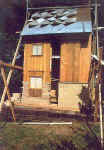
|
Figure
10: Mock-up testing building materials, patterns and proportions. |
Conclusion
For all of these projects, the Wertheimer Tor, Agate
Street, and Amazon Village, there are several principles and processes that
were used and that may have the potential to be applied in a more general
sense in the creation of buildings within the context of ordinary form
languages. These principles and processes include:
-
The creation of a Pattern Language or Project Language to accurately describe the visions and qualitative aspects of a project, based on input from users.
-
The use of stake-outs and mock-ups to more accurately test the placement and size of buildings and building elements.
-
The creation of positive space.
-
The allowance for variation at all levels of scale as it becomes needed through the design and building process.
-
The implementation of new construction techniques that make use of modern technology yet also reinforce the existing building culture.
These principles and processes are just a few that may be used to try and make
successful projects that work within the context of an ordinary form language.
Other principles and processes, such as the formation and use of design
guidelines have also been used with some success. Yet all of these attempts
are only a small step towards the recognition and importance that these
environments should have. While it is true that the majority of buildings
being built today are quite ordinary, the attitude of most architects today is
to focus attention on the flashy “object” buildings that continually
receive awards and recognition. It takes time and effort, and an attitude of
humbleness, to first try and really understand an environment with an ordinary
form language, and then try to work within this context in an additive and
supportive way. But this is in fact critically important, so that ordinary
form languages can continue to survive and evolve as an essential element of
our built environment. What more important role can an architect play than
that of improving and caring for the existing environment and identity of a
place? I conclude with a
quotation by N. John Habraken, from his book The
Structure of the Ordinary:
“(The) Built environment develops and extends in
fields: urban, suburban, rural. Built fields retain their identity for
centuries, continually transforming while remaining faithful to the relations
of their constituent parts. They are sustained by local and incidental acts of
architecture and urban design: variations on environmental themes that
rejuvenate extant fabric. The idea that a living environment can be invented
is outmoded: environment must be cultivated. After all, it is by the quality
of the common that environments prosper and by which, ultimately, our passage
will one day be measured.”
